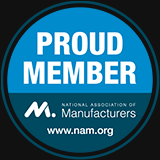 Courtesy of Tyler Ruffino
Courtesy of Tyler RuffinoHow does waterjet cutting work?
There are various machine tool processes for cutting materials, including waterjet cutting, laser, plasma, and more. To most, the idea of using water to cut through industrial materials may seem surprising. However, in manufacturing and processing, it’s a process growing in popularity due to its versatility and ease of operation. Waterjet cutters are often used in metal fabrication, but applications range from used from creating custom floor tiling to cutting frozen meat in food processing.
So how does water cut through such tough materials? The key is waterjet pumps' ability to force ultrahigh-pressure water through a tiny nozzle. The jet of water strikes the work surface, and the erosive force of the water removes material, not unlike a saw or any other cutting mechanism achieved by abrasion. The high pressure from the waterjet causes the water to flow at such a great velocity, that the force on impact is great enough to create shear in the work piece. That’s why waterjet machines always include the water pressure in its specs.
Pure water jets, which provide a very thin stream and therefore cut width, are used to cut soft, light materials such as silicone, foam, cork, plastic, and more. Applications include disposable diapers, tissue paper, and automotive interiors.
Abrasive waterjets are the much more powerful version of waterjet technology. These machines include abrasives in the water to facilitate the erosion process. Since the abrasives option can also be switched off, abrasive waterjets can cut through virtually any material, from paper to steel.
 An intensifier pump is used to create high pressure water.
An intensifier pump is used to create high pressure water.
Interested in buying a new waterjet table?
If you’re in an industry that involves cutting processes, chances are you’re already familiar with waterjets. Have you considered adding waterjet cutting capabilities to your shop? There are many considerations when selecting a cutting method.
One consideration is accuracy: an advantage of waterjets is that they can make parts to very tight tolerances, which translates to cost-savings due to greater material utilization. However, if precision is more important than speed for you, certain processes such as electrical discharge machining can often achieve even higher precision.
Waterjets also do not require as much uniformity of material, as compared to processes such as laser cutting or electrical discharge machining (EDM). They also do not cause thermal distortion or hardening as no heat is involved. This is an advantage over processes that cause heat transfer, such as laser, plasma and flame cutting.
Compared to laser cutting, abrasive waterjets can machine certain materials lasers cannot, such as reflective metals like aluminum or copper. Furthermore, unlike machining or grinding, waterjets have the benefit of not producing dust or particles that are harmful if inhaled.
A potential disadvantage of waterjet cutting is that the abrasives used are usually disposed, so they constitute an additional operational cost. However, abrasives management systems are becoming more available, which may be an investment worth considering due to their ability to recycle a portion of used abrasives.
Interested in affordable and reliable cutting equipment? Shop our selection:






